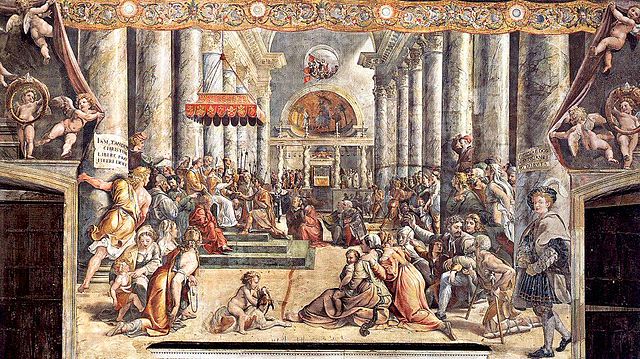The Donation of Constantine is a forged Roman imperial decree by which the 4th-century emperor Constantine the Great supposedly transferred authority over Rome and the western part of the Roman Empire to the Pope. Composed probably in the 8th century, it was used, especially in the 13th century, in support of claims of political authority by the papacy.
A 13th-century fresco of Sylvester I and Constantine the Great, showing the purported Donation (Santi Quattro Coronati, Rome)
A 9th century copy of the Donation of Constantine as part of the False Decretals by Pseudo-Isidore. The heading in red reads "Epistola Constantini Imperator ad Silvestrum Papam," or "Letter of Emperor Constantine to Pope Sylvester."
Workshop of Raphael, The Donation of Constantine. Stanze di Raffaello, Vatican City
Constantine I, also known as Constantine the Great, was a Roman emperor from AD 306 to 337 and the first Roman emperor to convert to Christianity. He played a pivotal role in elevating the status of Christianity in Rome, decriminalizing Christian practice and ceasing Christian persecution in a period referred to as the Constantinian shift. This initiated the cessation of the established ancient Roman religion. Constantine is also the originator of the religiopolitical ideology known as Constantinism, which epitomizes the unity of church and state, as opposed to separation of church and state. He founded the city of Constantinople and made it the capital of the Empire, which remained so for over a millenium.
Head of the Colossus of Constantine, Capitoline Museums
Mosaic in the Hagia Sophia, section: Maria as patron saint of Constantinople, detail: donor portrait of Emperor Constantine I with a model of the city
Remains of the luxurious residence palace of Mediana, erected by Constantine I near his birth town of Naissus
Head from a statue of the emperor Diocletian







